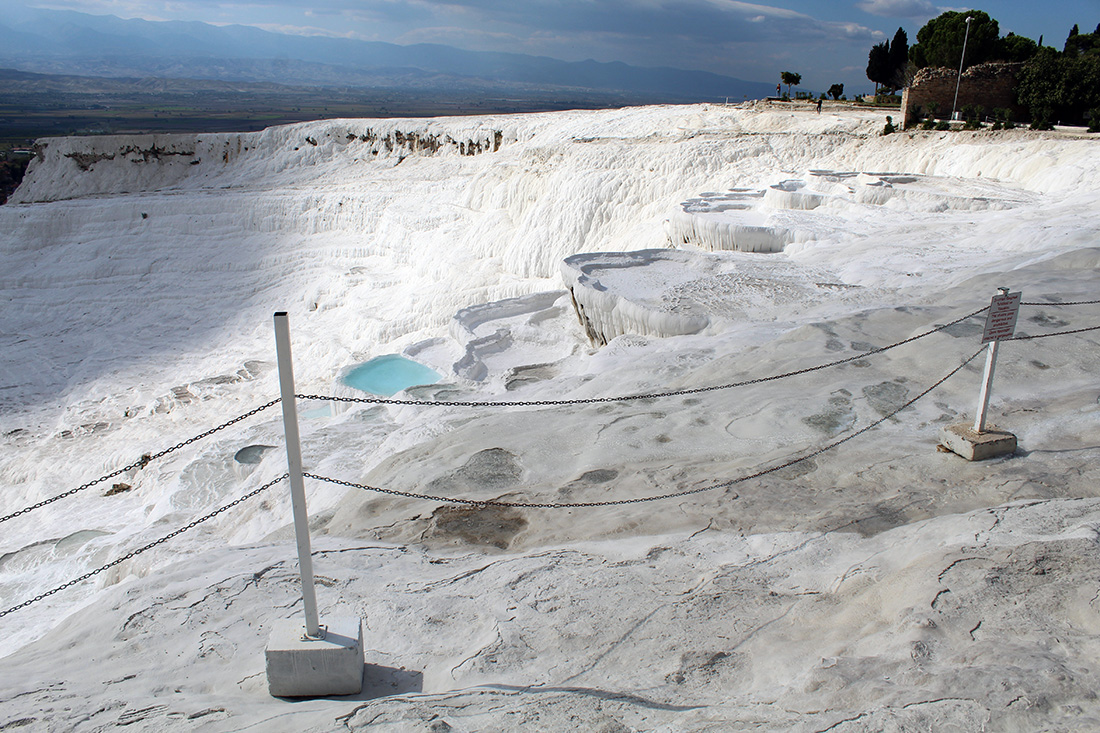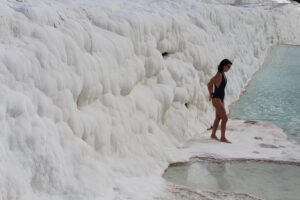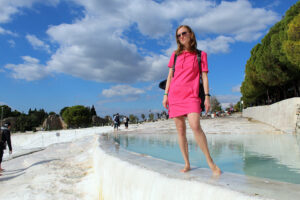I would not be surprised if my readers have seen the incredibly beautiful white terraces with azure water in Turkey at least once in their lives. They can often be seen in tourist posters about Turkey and in romantic videos.

Indeed, beautiful and dazzling Pamukkale is one of the main natural attractions of Turkey.
Legends of Cotton Mountain
To the north of the city of Pamukkale in Denizli province is a mountain. People call it Cotton Mountain or Cotton Castle for its characteristic white top. But in fact it is not cotton that covers the top, but a natural formation called travertine and the snow-white stone travertine.
According to legend, the mountain was named Cotton Mountain because of the Titans. They grew cotton and piled it up in large piles to dry in the sun. One day, they forgot about the crop – it withered and hardened, and thus a big white mountain appeared – Cotton Mountain or Cotton Castle.
Another legend has it that an ugly girl lived in these parts. She despaired of ever getting married, so she threw herself down the mountain to end her life. She fell into the lake where the water flowed from the spring and lost consciousness. Just at that moment a young man passed by. He saw a girl of incredible beauty and fell in love with her. Soon they got married and since then they come to the mountain not only for health, but also for beauty…
At the foot of the mountain is a lake with a park, an island, and swans. Perhaps this is where the unfortunate girl fell, and this is where all excursions begin – before driving up the mountain itself.
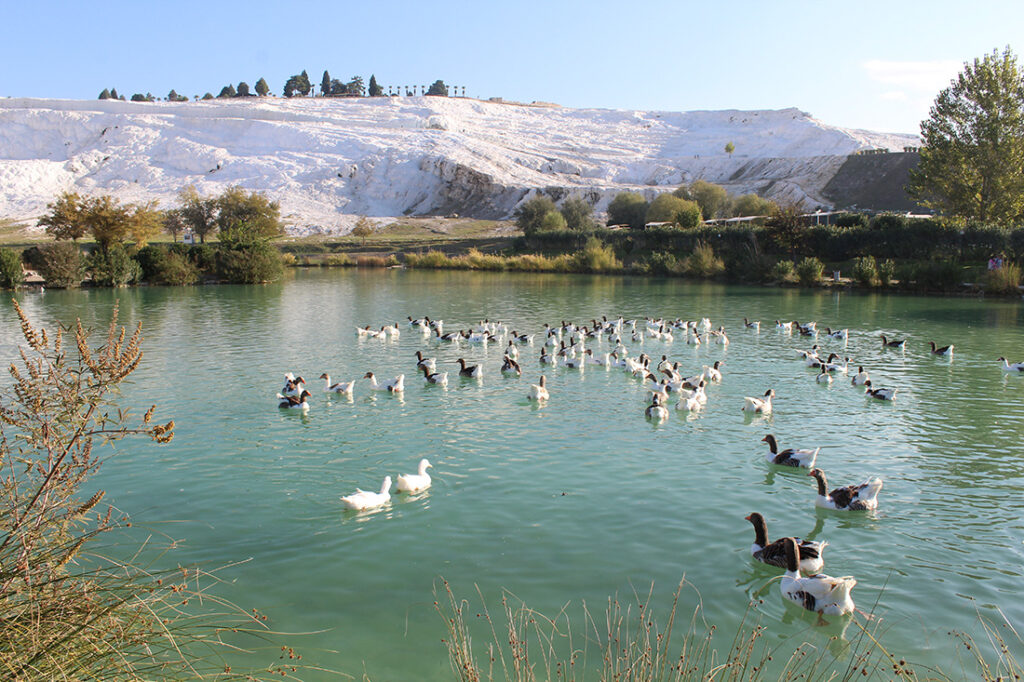
Pamukkale Travertines
There are 17 thermal springs with water temperatures ranging from 35 to 100 degrees Celsius in the vicinity of Cotton Mountain. And the most interesting thing is that the white crust is formed from a single spring. It forms in the depths of the mountain, breaks out and flows down through the multi-level terraces. It has a flow rate of up to 466 liters per second. The white sediment is carried down a distance of 60-70 meters and the flow of water is regulated by man according to the desired channel.
The white crust and then the stone form because there is a lot of calcium in the spring water. When the water is exposed to air, all the carbon dioxide escapes, but the calcium carbonate remains. It settles as a soft substance, gradually hardening and turning into a hard rock – travertine.
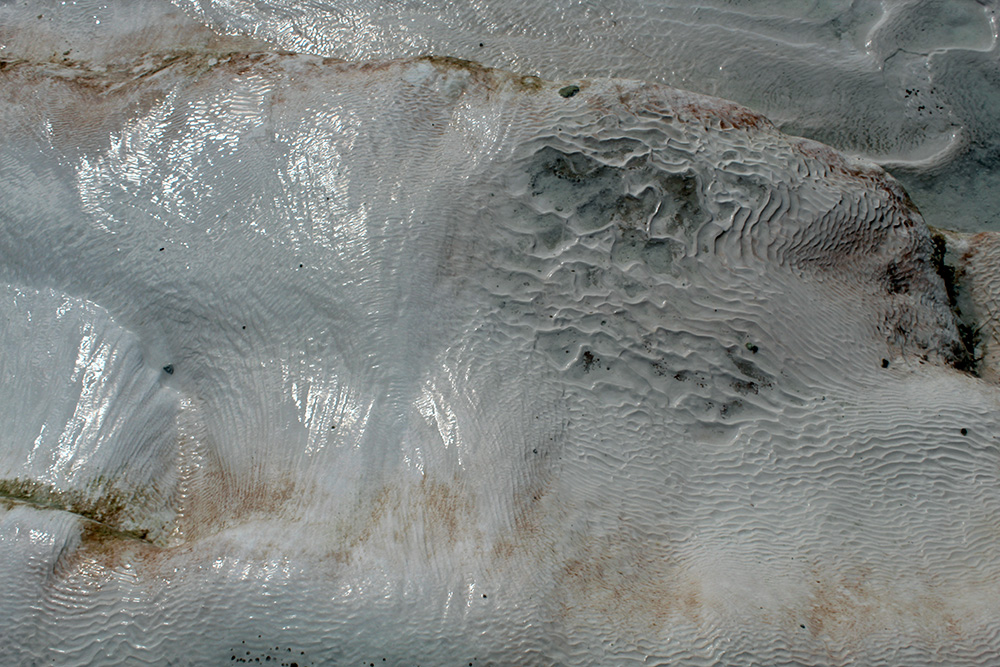
Baths with water in them are called travertine. It can take hundreds of years to harden, and the rock itself is continuously forming.
Because of this, the entrance of tourists to some parts of the cascade of travertine is prohibited – although people break the ban and interfere with the natural process.
In fact, it is sad – the complex suffers greatly from the large influx of people and a lot of effort and money is spent to restore and maintain it.
It is also forbidden to swim in the bathtubs – only to walk on the water and take pictures. When you are inside you have to be careful – you can easily slip and get injured – it is a very hard surface.
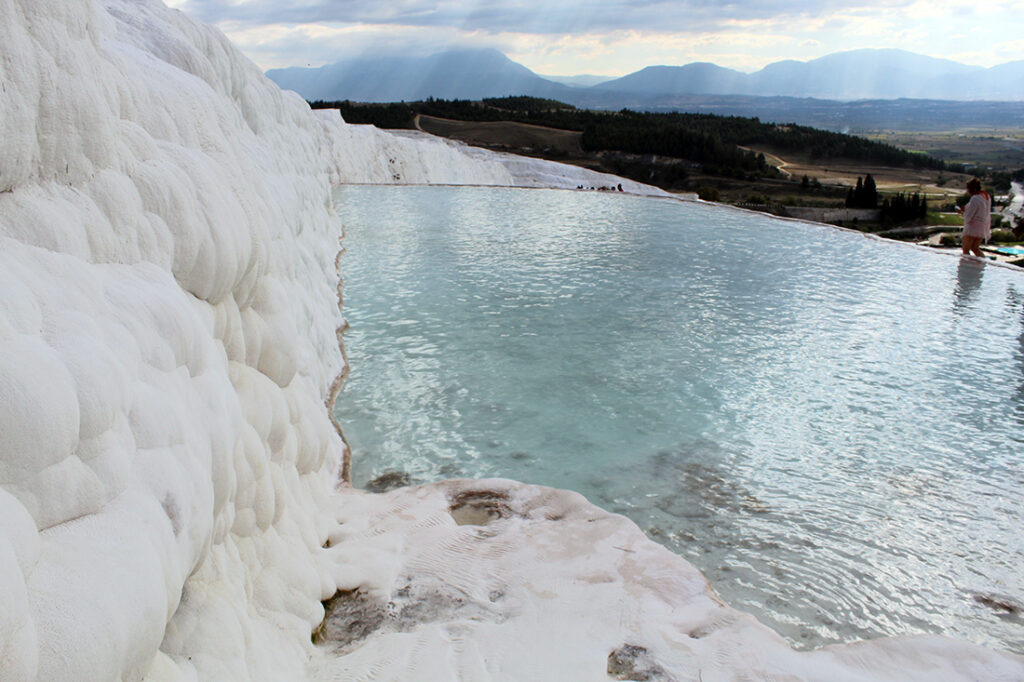
The travertines are very beautiful, the water is nice. Be sure to take a photo as a memento. I’ve seen people do whole photo shoots here with changing clothes as well.
The travertine complex covers a total of 1,000 hectares. There are more than 20 thousand tubs – ranging in size from a few centimeters to hundreds of meters square and up to 2.5 meters deep.
Now the entrance to the mountain is paid – 110 liras per person to visit the springs of the ancient city. The springs themselves do not require additional entrance fees. It is an open area and there are always a lot of people here.
Cleopatra Pool
The only exception is the “Cleopatra Pool” which stands aside. It costs 150 lira for adults and 70 lira for children from 12 years old. The only exception is the Cleopatra Swimming Pool, which costs 150 lira for adults and 70 lira for children under 12 years of age. It is believed that the water here is curative and Cleopatra herself was said to have bathed here to preserve her beauty and youth. Most likely, it is a romantic legend for tourists, which was invented in modern Turkey.
The Ancient City of Hierapolis in Pamukkale
In the second millennium B.C., the ancient city of Hierapolis grew up near the travertine of Pamukkale. Its ruins and springs are part of the UNESCO World Heritage Site called “The Ancient City of Hierapolis and Pamukkale Springs”. It is protected by law and the Turks are very careful about it.
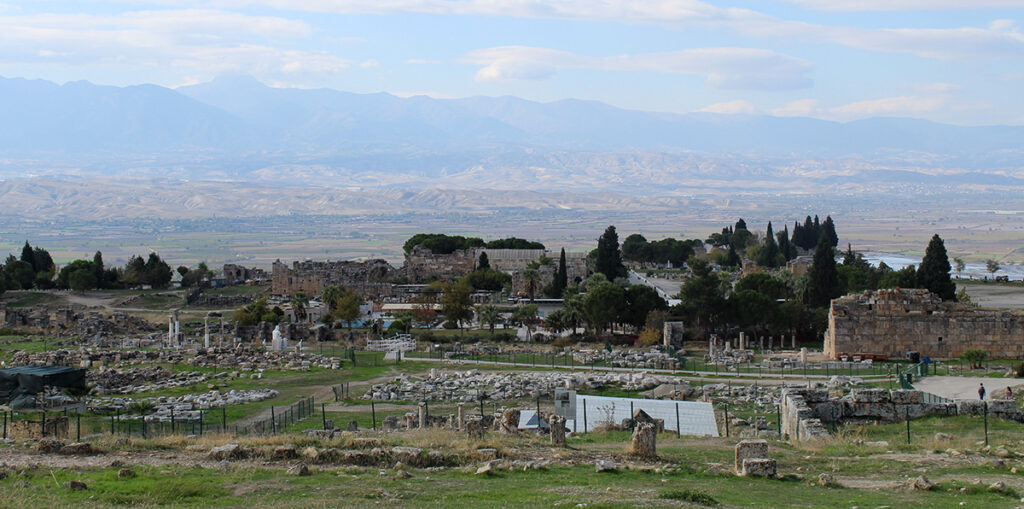
Modern Pamukkale and Singing Cocks of Denizli
In modern Turkey, the springs got their name from the nearby town of Pamukkale-Koyu. This area is famous not only for its open-air spa, but also for its cotton fields, the art of carpet weaving, good vineyards and lavender fields nearby.

The city is small and more like a quiet village. There are no high-rise buildings, many pensions buried in greenery and private houses. The nearest big city is Denizli, 20 km away.
The center of the province is famous for its textile production and medical institutes – they say it is good for eye surgery.
This is not surprising – clothing, beauty and health. Just such is the fame of this area since ancient times.
The region is also famous for its special roosters. In many villages you can find statues of these birds. This species can roost for a very long time – up to 30 seconds at a time. The locals organize competitions to see whose rooster will sing the most. They can scream so long that they faint from it. The breed is one of the pride of Turkey.

There are many cafes, souvenir shops, travel agencies, and parking lots in this small town. Many tourists come here and they all need to be served!
How to get to the Cotton Mountain in Pamukkale
The springs of Pamukkale and the ancient city of Hierapolis are visited by many excursions from the main tourist centers of the country – Antalya, Side, Alanya, Kemer, Belek. Marmaris. The way here from these cities is 250 – 350 km. So you will have to prepare for a long trip, and the departure will be after dark, so that you arrive at the resort is not too late.
Tourists will be brought by bus in the morning, will be guided through the complex on the mountain. Then there will be an obligatory passage through the store with wine, sweets and other souvenirs. As a rule, if you buy them it will be more expensive than in a regular store.
If you come on your own, it is better to visit the place in the morning – when there are no crowds of tourists. Also, for an independent visit in relative peace suitable spring – early summer, autumn. At this time, the temperature is comfortable and there is no influx of organized groups – they come mostly in the summer.
Interesting facts about Pamukkale travertine
- All the baths that can be walked on by tourists – created artificially. Their formation by natural process took 2 years. From 2007 to 2009;
- In 2012 there was filmed a Hollywood movie with Nicolas Cage, “Ghost Rider 2”;
- In ancient times, the spring’s waters were used not only for beauty and healing, but also for processing sheep’s wool;
- If you come here in early spring, you can catch the poppy blossoms nearby and see the whole plateau covered with these flowers.


